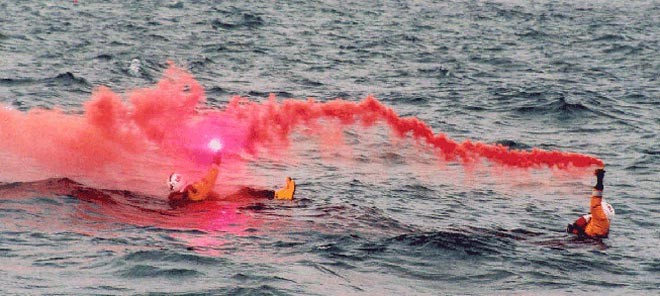Five Marine Flare Steps Every Sailing Skipper Needs to Know!
by John Jamieson on 29 Jul 2011

Flares have varying procedures and instructions - they need familiarisation when there is no emergency SW
John Jamieson (Captain John),with 25+ years of experience shows sailing skippers the skills they need for safer cruising. Here he points out the necessity to have you and your crew proficient with flares BEFORE you need them:
Blinding rain or squall, howling wind, heavy seas, smoke filled compartments. If you've been in a situation like this, you know these are not ideal conditions. But when an emergency at sea strikes, you and your crew may need to use unfamiliar lifesaving equipment--like distress flares. Are you and they ready?
Are you sure you know how to use a flare gun, flare launcher, flare smoke, or flare parachute? Water or fire could damage radio equipment in an emergency at sea. Now what, skipper?
A Tragedy Caused by Lax Safety Standards:
At 2:20 am, Monday, April 15th, 1912, the Titanic slid beneath the waves of the Atlantic, leaving her passengers and crew fighting for their lives in 31°F (-1°C) water. Most died from drowning--not hypothermia. Survival time in water that cold averages between fifteen to twenty minutes.
If the right safety equipment had been aboard, none of this would have happened. Matter of fact, those passengers and crew had over two hours to make preparations and abandon the ship.
But, they were unable to do so because of the lax standards in the shipping industry at that time. But it was to be nevermore...
Out of great tragedy often comes a great awakening. An international committee was formed to study the tragedy and come up with new safety standards.
Safety equipment was beefed up and no ship sailed without enough lifeboats for her passengers and crew. This committee went by the name of Safety Of Life At Sea--or SOLAS.
Why Choose SOLAS Marine Flares?
Today, SOLAS equipment is recognized throughout the maritime world as the finest, most reliable that money can buy. No racing sailboat can sail offshore without SOLAS equipment aboard. From flares to launchers to liferafts to liferaft equipment.
If you want the best of the best, insist on SOLAS certified equipment. They may cost more, but they're 30 to 50 times brighter, can shoot up to 1000 feet in the air, and can be seen for up to 41 miles.
All flares come with illustrated instructions on the flare body. SOLAS flares are easier to follow and much easier to see in tough conditions of smoke, rain, fog, or at nighttime.
Five Simple Steps to Fire Any Marine Flare Like a Pro:
Learn the correct way to ignite or fire any marine distress flare, and practise it over and over, because after reading the steps below you'll know you won't have time to practise when an emergency strikes. Remember it could save your life or the life of your crew one day! Practice and train your crew in the use of emergency flares frequently as well, because you'll also want your crew to know what to do in case you become incapacitated.
1. Put your back to the wind. Move to the edge of the boat. Brace yourself as the vessel pitches and rolls.
2. Follow the instructions to open the marine flare. Never, ever assume that you just take off a cap and ignite it. With some flares, you must remove one cap; others require that you remove both caps. If you use a flare gun, flare pistol, or flare launcher, learn how to load it before an emergency strikes. Some flare gun shells load from the inside of the barrel and others from the outside. Read the manufacturer's instructions first.
3. Wear protection. You must protect your eyes at all costs. If the wind changes direction, hot flare slag could blow back toward you. Wear common eye or sunglasses. Keep a pair of heat-resistant gloves handy, because SOLAS flares can get quite warm.
4. Hold a handheld or parachute flare in your non-dominant hand. Hold a flare gun in your dominant hand. Make a straight arm and hold your arm up at a 45 degree angle. With handheld marine flares, cock your wrist to slant it away from you. These flares drip melted element--called slag--as they burn. You want hot slag going into the water--not onto your hand!
5. Look to one side. Do not watch the flare, flare gun, or parachute when you ignite it. This gives extra protection for your eyes. Drop the expended flare body or shell case into the water.
WARNING!
If the handheld flare, flare parachute, or flare gun shell fails to ignite, do not make a second attempt to fire it. Drop the flare or shell case into the water.
None of us ever hopes to have to use our marine flares. Prepare yourself and your crew now with the five safety steps so that you will be ready if the unexpected comes your way--wherever in the world you choose to sail!
Visit John Jamieson(Captain John)'s website at www.skippertips.com to sign up for a free sailing tips newsletter. As a member you will receive instant access to 400+ sailing articles, sailing video tutorials, live discussion forums, sailing topic eBooks, and much more.
If you want to link to this article then please use this URL: www.sail-world.com/86528